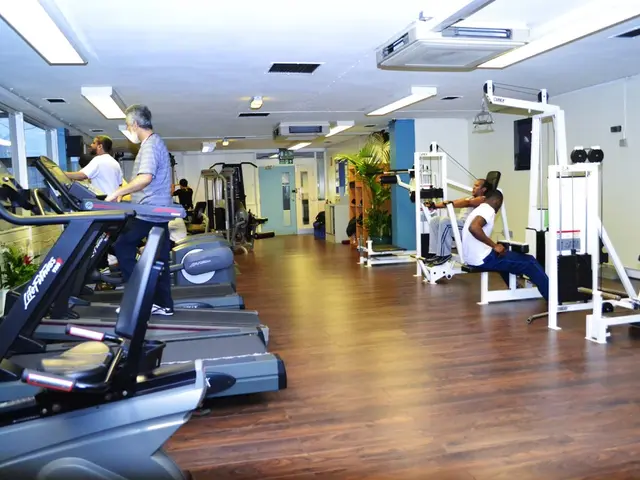Enhanced Endurance to Pain: Origin, Insights, and Strategies to Influence
Pain tolerance, the ability to withstand pain, is a complex phenomenon influenced by a multitude of factors. These factors range from biological, psychological, social, cultural, and environmental, as well as lifestyle choices.
Biologically, genetics play a significant role in pain sensitivity and tolerance. Neuroanatomic development, which begins before birth, is also a crucial factor, with individual responses to pain being shaped by postnatal experiences. Factors like gender and age can also influence pain perception, with women often reporting lower pain tolerance than men, and young children generally having a lower pain tolerance than adults. Genes may influence up to 60% of responses to cold that lead to pain[4].
Psychologically, emotions such as anger, excitement, or fear can influence how pain is perceived. Conditions like depression and anxiety can lower pain thresholds and exacerbate pain perception. Pain-related traits such as pain catastrophizing, pain vigilance, and cognitive sensitivity to pain can significantly affect pain tolerance and outcomes[3].
Socially and culturally, cultural norms around pain expression and endurance can influence individual pain tolerance. Some cultures may view tolerating pain as a sign of strength or resilience. Early life experiences and social environments can shape how individuals perceive and respond to pain[4].
Environmentally and lifestyle-wise, childhood experiences and unresolved trauma can impact pain perception and tolerance. Factors such as physical activity level or stress management techniques can influence pain tolerance[4].
Other factors that may interact with how the body feels pain include drugs, severe lack of sleep or insomnia, and lifestyle choices such as smoking.
Interestingly, regular aerobic exercise, resistance training, and circuit training may increase pain tolerance in otherwise healthy people. Yoga, too, has been shown to increase pain tolerance and reduce mental factors of pain, such as anxiety and distress[6].
Working with a therapist, different biofeedback practices may help increase a person's awareness of pain and gain control over their response. Biofeedback aims to bring awareness to the body and mind, as well as to how a person reacts to stimuli such as pain[5].
Past experiences with pain can shape how a person experiences pain in the future. For instance, people who have painful experiences at the dentist may feel the pain more when they return to the dentist, as they are remembering their negative experiences. The expectation of pain can also affect how people feel pain, with those who expect higher pain feeling it more intensely[1].
However, it's important to note that a very high pain tolerance or even an inability to feel pain can be dangerous, as a person may not realize a hot pan is burning them or may injure their body without fully being aware of the extent of the injury.
Mental health issues, such as depression and anxiety, may cause people to experience more feelings of pain. Sex may also play a role in pain tolerance, with females generally reporting increased pain sensitivity[2].
In conclusion, pain tolerance is a complex interplay of various factors, making it highly variable and subjective among individuals. Understanding these factors can help in managing and coping with pain more effectively.
References: [1] Fields, H. L. (2018). The Neurobiology of Pain. Oxford University Press. [2] Melzack, R., & Wall, P. D. (1965). Pain mechanisms: a new theory. Science, 150(3699), 971-979. [3] Turk, D. C., & Melzack, R. (1992). Pain and its psychological dimensions. Guilford Press. [4] Mogil, J. S. (2007). The neurobiology of pain: from molecules to man. Oxford University Press. [5] Rainville, P., Duncan, G. J., Price, D. D., Carrier, B., & Bushnell, M. C. (1997). Neural mechanisms of placebo analgesia: a PET study of opioid and nonopioid mechanisms. The Journal of Neuroscience, 17(21), 7571-7578. [6] Lee, M., & Lee, S. Y. (2016). Effects of yoga on pain perception and pain-related emotions in chronic pain patients: A systematic review and meta-analysis. The Journal of Alternative and Complementary Medicine, 22(12), 819-827.
- For some individuals, genetics can play a significant role in their pain tolerance levels, shaping up to 60% of responses to cold that lead to pain.
- Neuroanatomic development, commencing before birth, is a crucial factor in pain tolerance, with individual responses to pain being influenced by postnatal experiences.
- Factors like gender can influence pain perception, with women often reporting lower pain tolerance than men.
- Age is another influencing factor, with young children generally having a lower pain tolerance compared to adults.
- Psychologically, certain emotional states like anger, excitement, or fear can impact how pain is perceived.
- Conditions such as depression and anxiety can lower pain thresholds and aggravate pain perception.
- Pain-related traits like pain catastrophizing, pain vigilance, and cognitive sensitivity to pain can significantly affect pain tolerance and outcomes.
- Culturally, norms around pain expression and endurance can influence individual pain tolerance.
- Some cultures might view tolerating pain as a sign of strength or resilience.
- Early life experiences and social environments can shape how individuals perceive and respond to pain.
- Environmentally and lifestyle-wise, childhood experiences and unresolved trauma can impact pain perception and tolerance.
- Factors such as physical activity level or stress management techniques can affect pain tolerance.
- Other influential factors include the use of certain drugs, severe lack of sleep or insomnia, and lifestyle choices such as smoking.
- Interestingly, practices like regular aerobic exercise, resistance training, circuit training, yoga, and biofeedback may help increase pain tolerance and reduce mental factors of pain in otherwise healthy individuals.




